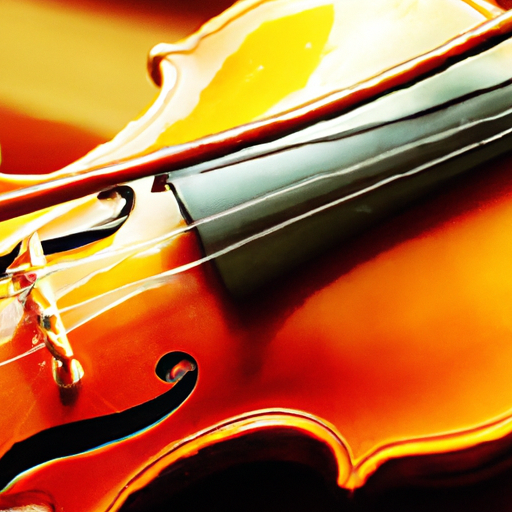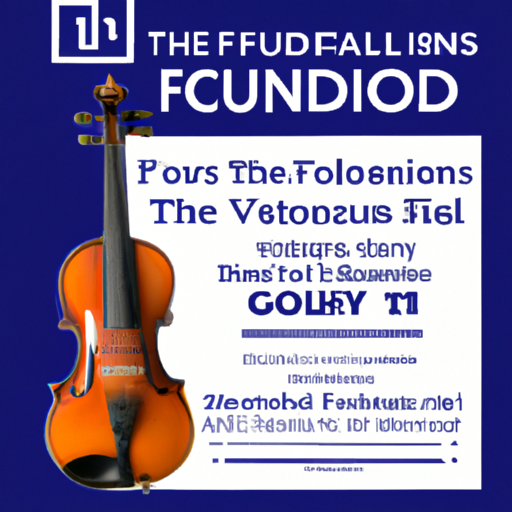
Playing the violin is a beautiful and rewarding experience. Whether you are a beginner or have some experience, it is crucial to learn the basic techniques that will lay the foundation for your violin journey. In this article, we will explore the essential skills and knowledge that every new violin player should acquire. By understanding the anatomy of a violin, proper posture and holding techniques, bowing techniques, finger placement and string crossing, playing scales and arpeggios, music theory and sheet music reading, tuning the violin, and practicing basic exercises, you will be well on your way to becoming a proficient violin player.

Learning the basic techniques is crucial for new violin players as it sets the foundation for their musical journey. Mastering these techniques will enable you to produce a beautiful sound, play with proper intonation, and prevent any potential injuries or bad habits. It is essential to build a strong technical foundation from the beginning to progress smoothly and efficiently in your violin playing.

This article aims to provide a comprehensive guide to the basic techniques for new violin players. It covers various aspects such as understanding the anatomy of a violin, proper posture and holding techniques, bowing techniques, finger placement and string crossing, playing scales and arpeggios, music theory and sheet music reading, tuning the violin, and practicing basic exercises. Each section will provide valuable insights and tips to help you develop your skills and become a confident violin player.
To understand how the violin produces sound, it is essential to familiarize yourself with its various parts. The main components of a violin include the body, the neck, the fingerboard, the bridge, the soundholes, the chinrest, and the tailpiece. Each part plays a crucial role in producing the unique and resonant sound of the instrument.
Every part of the violin contributes to its overall sound quality. The body and soundholes resonate the vibrations created by the strings, while the bridge transmits these vibrations to the body. The fingerboard determines the length of the vibrating string, which affects the pitch of the notes. The chinrest and tailpiece provide stability and support while playing. Proper care and maintenance of these parts ensure optimal sound production and longevity of the instrument.
Proper care and maintenance of your violin are essential to preserve its beautiful sound and prolong its lifespan. It is crucial to keep the instrument clean, store it in a suitable case, and protect it from extreme temperatures and humidity. Regularly changing the strings and applying rosin to the bow hair are also crucial maintenance practices. Additionally, it is advisable to have your violin inspected and serviced by a professional luthier periodically.
Holding the violin with the correct posture is vital for producing a good sound and preventing injuries. Your feet should be shoulder-width apart, with your weight evenly distributed. Your back should be straight, and your shoulders relaxed. The violin should be positioned parallel to the floor, with the left shoulder supporting its weight.
Properly holding the violin ensures that you have full control over the instrument and can execute the necessary techniques effectively. Holding the violin securely prevents any unnecessary tension or strain on your body, allowing you to play with ease and fluidity. It also helps in maintaining proper intonation, as any instability or movement of the instrument can affect the accuracy of your finger placement.
To hold the violin comfortably, it is essential to find a balance between stability and flexibility. Experiment with different chinrest and shoulder rest options to find the most comfortable setup for your body. Make sure to relax your jaw and neck muscles while supporting the violin with your chin and collarbone. Regularly check for any tension in your arms, wrists, or shoulders and release any unnecessary pressure.
The bow hold is a fundamental aspect of violin playing. Hold the bow with a relaxed and flexible grip, allowing for smooth and controlled movements. Place your thumb on the frog of the bow, slightly bent. The middle and ring fingers should lightly rest on the bow, while the index finger provides balance. The pinky finger should curve around the bow, providing stability and control.
Understanding bowing direction and pressure is essential for producing different dynamics and articulations. To produce a clear and resonant sound, the bow should be drawn parallel to the bridge and perpendicular to the strings. The speed and pressure of the bow determine the loudness and intensity of the sound. Experiment with different bowing techniques to achieve a variety of musical expressions.
Consistent practice and attention to detail are crucial for improving your bowing technique. Start with slow and controlled bowing exercises, focusing on producing a consistent and even sound. Gradually increase the speed and intensity of your bow strokes while maintaining control and accuracy. Regularly check your bow hold and ensure that your wrist and arm movements are fluid and relaxed.
Accurate finger placement is crucial for playing the correct notes on the violin. The fingerboard is divided into different positions, with each finger corresponding to a specific note. Practice placing your fingers precisely on the fingerboard, ensuring that they are close to the strings without pressing too hard. Developing muscle memory and finger strength will help you navigate the fingerboard confidently.
String crossing involves smoothly transitioning from one string to another while maintaining accurate intonation. To cross strings without losing intonation, practice shifting your finger placement smoothly and efficiently. Focus on maintaining a consistent finger angle and pressure throughout the string crossing. Gradually increase the speed and complexity of your string crossing exercises to develop fluidity and accuracy.
Exercises that specifically target finger placement and string crossing can greatly improve your accuracy and coordination. Start with simple exercises, such as playing scales and arpeggios, focusing on clean string crossings and precise finger placement. Utilize slow practice techniques, such as using a metronome, to develop control and accuracy. Regularly monitor your finger position and make adjustments as necessary.
Scales and arpeggios are essential exercises for developing technique, intonation, and finger strength on the violin. They provide a systematic approach to practicing different finger patterns and help in understanding the underlying musical structure. Regularly practicing scales and arpeggios will enhance your overall playing ability and enable you to tackle more challenging repertoire with ease.
Start by learning the major and minor scales in different keys, gradually increasing the difficulty level. Practice playing scales with different bowing patterns, such as separate bows, slurred bows, and spiccato. Focus on producing a consistent and even sound, with precise finger placement and intonation. Similarly, practice arpeggios using various bowing techniques, paying attention to the musical phrasing and dynamics.
Consistency and regularity are key to mastering scales and arpeggios. Set aside dedicated practice time for scales and arpeggios, focusing on accuracy, speed, and fluidity. Utilize practice techniques such as playing scales in different rhythms, dynamics, and tempos to develop versatility. Record yourself playing scales and arpeggios to identify areas for improvement and track your progress over time.
Developing a basic understanding of music theory is crucial for interpreting and performing music on the violin. Familiarize yourself with concepts such as musical notation, key signatures, time signatures, and intervals. Learn to identify and understand the different symbols and markings on sheet music, such as dynamics, articulations, and phrasing indications. This knowledge will enable you to approach the music with a deeper understanding and bring out its intended musical expression.
Reading sheet music for the violin involves interpreting the notes, rhythms, and other musical symbols written on the staff. Begin by learning the names and positions of the notes on the staff, as well as their corresponding finger placement on the violin. Practice sight-reading exercises regularly to improve your reading proficiency. Gradually progress to more complex pieces, challenging yourself to read ahead and anticipate upcoming notes and rhythms.
Consistent practice is key to improving your music theory and sheet music reading skills. Set aside dedicated practice time for studying music theory concepts and sight-reading exercises. Practice identifying and naming notes on the staff, both in isolation and within musical phrases. Use sight-reading apps or online resources to access a wide range of sheet music and challenge yourself with various musical styles and genres.
Tuning the violin is an essential part of violin playing. Playing with an out-of-tune instrument not only affects the sound quality but also hinders your ability to play in tune with other musicians. Regular tuning ensures that your violin is ready to produce the best sound possible, allowing for accurate intonation and harmonious playing.
To tune the violin correctly, you will need a reference pitch, such as a tuning fork or a piano. Start by tuning the A string using the reference pitch. Once the A string is in tune, use it as a reference to tune the other strings (D, G, and E). Adjust the tension of each string using the fine tuners or the pegs until they match the desired pitch. Regularly check the tuning while playing to maintain accurate intonation.
Keep in mind that the violin's pitch can be affected by temperature and humidity. It is advisable to tune your violin before each practice session or performance to ensure optimal intonation. Use an electronic tuner or tuning app for more precise tuning. Develop your ear training by practicing tuning the violin solely by ear, listening for the correct pitch and adjusting accordingly.
Regular practice exercises are essential for developing and maintaining your violin technique. Exercises target specific technical challenges, such as finger dexterity, bow control, and coordination. They also help in building strength, flexibility, and muscle memory. Incorporating a variety of exercises into your practice routine will enhance your overall playing ability and enable you to tackle more challenging repertoire.
There are numerous exercises available for violin players at different skill levels. Some examples of basic exercises include finger exercises, such as playing scales and arpeggios in different positions and patterns, bowing exercises, such as spiccato and staccato exercises, and coordination exercises, such as double-stop and string-crossing exercises. These exercises can be found in method books, etudes, and online resources.
When practicing exercises, it is crucial to focus on accuracy, control, and consistency. Start with slow and controlled practice, gradually increasing the tempo and difficulty level. Use a metronome to develop your sense of rhythm and timing. Break down complex exercises into smaller sections and practice them separately before integrating them into the full exercise. Regularly monitor your technique and make adjustments to ensure proper form and execution.
Learning the basic techniques for the violin is crucial for new players as it sets the foundation for their musical journey. Mastering these techniques enables you to produce a beautiful sound, play with proper intonation, and prevent any potential injuries or bad habits.
Embarking on the violin journey can be challenging but immensely rewarding. Remember to be patient, dedicated, and consistent in your practice. Seek guidance from a qualified teacher who can provide personalized instruction and feedback. Enjoy the process of learning and discovering the endless possibilities of the violin. With time, effort, and a solid foundation in the basic techniques, you will unlock your musical potential and become a confident and skilled violin player.
For more information on violin lessons and rentals, visit https://bannhacflamenco.net/cho-thue-ban-nhac/luom-lat-tin-do-day/.